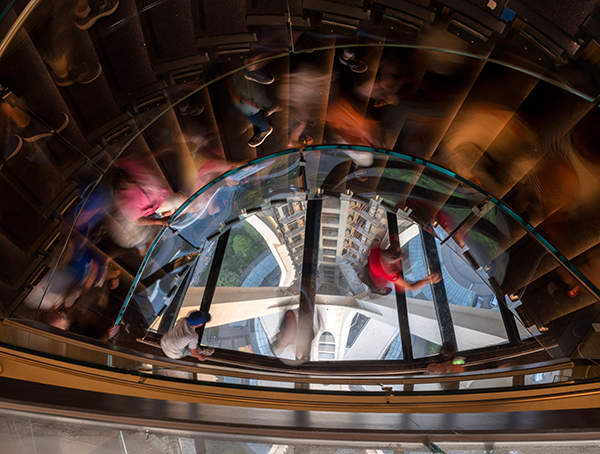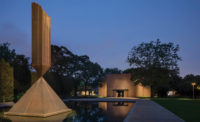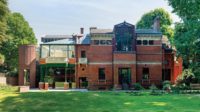Seattle’s quirky Space Needle began as a hotel promoter’s doodle. One architect—John Graham Jr.—designed the top, another—Victor Steinbrueck—the base. It was built in a breakneck 13 months. But since the 605-foot-tall Needle’s opening for the 1962 World’s Fair, over 60 million visitors have soaked in the views from the top. Dismissed as “gimmicktecture” by architectural intelligentsia at the time, the now-vintage “Space Age” shape, ranked Seattle’s skyline at number two for instant global recognizability—behind only Paris and the Eiffel Tower, according to one recent survey. Yet, up close and inside, the Needle was riddled with glitchy systems and clunky add-ons and work-arounds. The famed rotating restaurant, for instance, lurched and creaked.
In 2013, after a few years of exploring a rebrand, the Needle’s owners engaged the Seattle-based firm Olson Kundig to “get an architectural perspective.” Soon, partner Alan Maskin and project architect Blair Payson began brainstorming bigger moves than new finishes, logos, and slogans. Five years and $100 million later, the first and largest phase of “The Century Project,” a dramatic, top-to-bottom architectural reboot, is complete.
“Our work has really been about subtraction,” says Maskin, “peeling away all these walls, tiny little doors and floors and, in almost every case, replacing them with glass.” The architects worked to “widen the lens to create more ways to look at the city.” Indeed, Maskin and team have transformed the kitschy, aging icon into a joyous, interactive kinetic sculpture re-engineered with Swiss-watch intricacies.
The designers enjoyed unusual freedom from constraints that so often tether renovations of historic structures to era over improvement. The family whose firm built the Needle—the Wrights of Howard S. Wright Construction—own it, so all final decisions rested with that group. Originally engineered to double the era’s seismic codes and to withstand a Category 5 hurricane, the structure required mostly minor, easily hidden laterally stabilizing updates. The Needle is a locally designated landmark, but not on the National Register of Historic Places. Thus, Olson Kundig’s reinterpretations required only nods from an eleven-member local landmarks board.
The circumstances invited a rethink of the original designers’ intentions: an instrument for views. There are the grand panoramas, of course. But as Maskin notes, “The Eiffel Tower has views of itself. This was our chance to show off the original engineers’ and architects’ work.”
From the elevator doors’ parting, the Needle’s new transparency unfolds—25 percent more, according to the architects. Gone are the old pony walls and ribbon windows, replaced with floor-to-ceiling glass panels, glare-free courtesy of museum-grade, anti-reflecting coating. Widened stairs (one equipped with an elegantly hidden retracting wheelchair lift) step down and out to the observation deck where floor-to-sky expanses of structural glass—each panel weighing over a ton—cant outward over the city.
The once-solid steel floor is now ten layers of glass, the inner thermal barriers sandwiched between a fritted underside, to maintain the structure’s historic look from below, and a sacrificial top layer, easily stripped away when high heels have taken their toll.

Photo © Nic Lehoux
A new spiral staircase, terminating with a dizzying, downwardly aimed oculus, connects to what is being billed as the world’s first rotating glass floor, redubbed “The Loupe.” Long shuddering on a fixed 47-minute rotation along a greasy train-track system, the space—which will soon house a wine bar and, eventually, a restaurant—now glides as smoothly as an audiophile’s turntable. Designed with an Olson Kundig trademark, exposed kinetics, and engineered by Fives Lund, a company that normally moves rockets for Boeing and SpaceX, the system’s twelve small motors silently spin a single, platform-wide cog in either direction, the cycle adjustable from 20-90 minutes.
The renovation had its bumps and holdups. Demolition revealed unforeseen degradation. Top-to-bottom digital scanning of the entire structure showed so many quirks—the observation deck, for instance, is neither round nor flat—that every glass panel had to be custom-fabricated and fitted. An unusually windy winter periodically shut down crews working 500 feet in the air.
But, in the end, Maskin and Payson believe the renovation better fulfills the original designers’ ambitions. They turned up historic sketches displaying full-glass walls. Vintage photos show more carefree days for the Needle—before suicide jumps and prankster parachutists necessitated wire barriers—when visitors dangled over the railings to snap pictures downward. “People are using the space differently,” notes Maskin, as visitors rambunctiously scramble around the terrace, where sturdy glazing both highlights the thrilling elevation and allays related fears. “Now it’s like an adventure.”
As if on cue, a six-year-old carefully tests the glass floor, first over a beam. A tentative first step further out leads to a leap onto a thick glass bench and, finally, arms spread against the slanting glass wall for a Superman flight in the clouds.
“Right there,” observes Maskin, “a threshold crossed: a little risk, a big reward.”
Editor's Note, August 10, 2018: This story has been updated.












Post a comment to this article
Report Abusive Comment